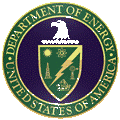United States Department of Energy

United States Department of Energy: Publications
Date of this Version
2011
Citation
Environ. Sci. Technol. 2011, 45, 951–957
Abstract
The fate of pertechnetate (99Tc(VII)O4 -) during bioreduction was investigated in the presence of 2-line ferrihydrite (Fh) and various dissimilatory metal reducing bacteria (DMRB) (Geobacter, Anaeromyxobacter, Shewanella) in comparison with TcO4 - bioreduction in the absence of Fh. In the presence of Fh, Tc was present primarily as a fine-grained Tc(IV)/Fe precipitate that was distinct from the Tc(IV)O2 ·nH2O solids produced by direct biological Tc(VII) reduction. Aqueous Tc concentrations (<0.2 μm) in the bioreduced Fh suspensions (1.7 to 3.2 × 10-9 mol L-1) were over 1 order of magnitude lower than when TcO4 - was biologically reduced in the absence of Fh (4.0 × 10-8 to 1.0 × 10-7 mol L-1). EXAFS analyses of the bioreduced Fh-Tc products were consistent with variable chain length Tc-O octahedra bonded to Fe-O octahedra associated with the surface of the residual or secondary Fe(III) oxide. In contrast, biogenic TcO2 ·nH2O had significantly more Tc-Tc second neighbors and a distinct long-range order consistent with small particle polymers of TcO2. In Fe-rich subsurface sediments, the reduction of Tc(VII) by Fe(II) may predominate over direct microbial pathways, potentially leading to lower concentrations of aqueous 99Tc(IV).

